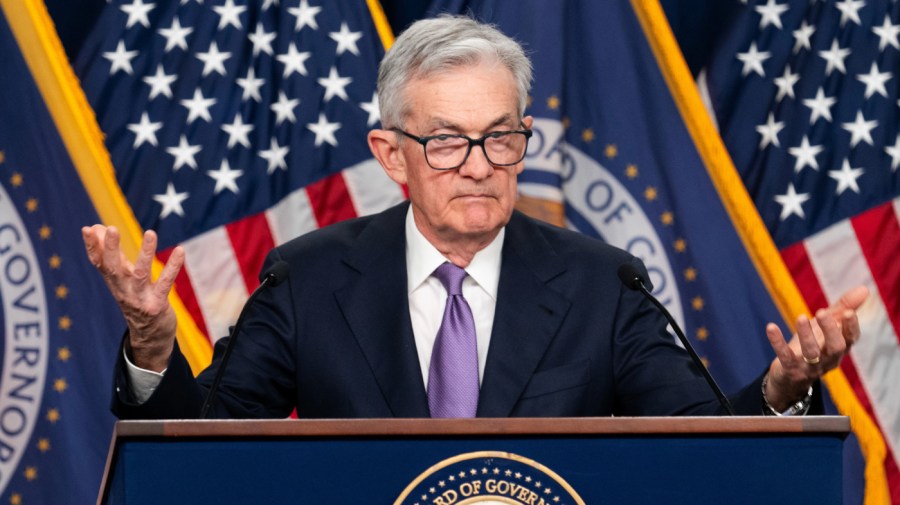
Investors are asking this question in the wake of a series of stronger-than-expected economic data and higher inflation readings in the first quarter of this year.
The latest surprises were March data showing a 303,000 increase in nonfarm payrolls and the Consumer Price Index inflation report that showed the headline rate increased to 3.5 percent over a year ago.
Whereas investors anticipated six cuts in the federal funds rate at the start of this year, the bond market is now pricing in only two cuts. While this is below the three cuts that Fed officials envision, some investors suspect the Fed will have to alter its assessment at some point.
Amid this, the 10-year Treasury bond yield has increased by nearly 70 basis points this year to 4.55 percent while the stock market rally has stalled this month.
As fears of recession have faded, investors are now debating whether the economy will attain a “soft landing” or “no landing.” The key difference is whether inflation will approach the Fed’s target of 2 percent, or stay around 3 percent.
According to a recent Deutsche Bank survey, 45 percent of investors now believe a “no landing” scenario is the most likely outcome. This compares with 38 percent of respondents expecting a “soft landing” and 17 percent foreseeing a recession this year.
Several considerations underlie the difference in views.
One issue is whether inflation will continue to decline after it fell rapidly last year. The latest Federal Reserve projections call for its preferred measure of inflation, the index of Personal Consumption Expenditure, to slow to 2.4 percent this year and to approach 2 percent by 2025-2026.
While some observers question whether this outcome is likely, Fed Chair Jerome Powell brushed aside these concerns at the March Federal Open Market Committee press conference. He stated that recent reports “haven’t really changed the overall story, which is that of inflation moving down gradually on a sometimes bumpy road towards 2 percent.”
Still, there is an ongoing debate about whether the “last mile” to price stability will prove the most challenging. The Bank for International Settlements came down on the side of caution in its 2023 annual economic report, arguing that central banks need to persevere in combatting inflation until they have attained their goals.
The main reason for the quick reduction in inflation is that goods prices softened considerably as supply-chain disruptions lessened and commodity prices fell. Prices for services, however, including implicit home rental rates, are stickier than for goods. Oil prices have also increased recently.
My take is it’s too early to tell whether inflation has stalled. What is evident is that the Fed has more room for maneuver than before. Also, surveys of long-term inflation expectations do not show significant shifts for households or investors.
This raises the issue of whether the Fed should ease monetary policy if inflation stays above its target.
One argument for doing so is that the Fed funds rate adjusted for inflation is close to a two-decade high at about 2.5 percent. New York Fed President John Williams contends that r* — the neutral real interest rate where policy is not expansionary or restrictive — is only about 0.5 percent. If so, the economy would likely weaken over time if the Fed kept interest rates unchanged.
However, Williams’ predecessor, Bill Dudley, counters that this assessment appears inconsistent with the strength of the economy and the easing in financial conditions. In his view, the Fed’s estimates of r* and its forecast that the funds rate will eventually plateau around 2.5 percent are too low.
Dudley points out that market participants anticipate that inflation is likely to be above 2 percent on average because the Fed altered its longer-run policy goals in August 2020 to make the Fed’s inflation target asymmetric: “The central bank is committed to offsetting downside misses with comparable misses to the upside, but not the other way around.”
I concur with Dudley’s assessment and believe the Fed should reinstate its previous symmetric commitment to a 2 percent inflation target at the next review of its policy framework in 2025. The reason: The commitment to reduce inflation in the 1980s and 1990s was integral to achieving the “Great Moderation” — the period of economic prosperity and relative macro stability that lasted for 25 years.
Meanwhile, investors should consider whether the clock is running out for the Fed to ease policy this year.
As economic data have surprised to the upside, bond traders no longer expect the Fed to ease monetary policy in June. If so, the Federal Open Market Committee meeting at the end of July is the only opportunity for the Fed to lower rates before the 2024 election campaign is in full swing after Labor Day.
Normally, the Fed prefers to be missing from action during the run-up to the election. With the November Federal Open Market Committee meeting scheduled immediately after the election, the December meeting would be the next opportunity.
Weighing these considerations, it is possible there could be no easing in monetary policy this year if inflation stays elevated. Meanwhile, Bloomberg reports that bond traders are preparing for 10-year Treasury yields to surpass 5 percent if that scenario unfolds.
For the time being, however, I don’t expect Fed officials to acquiesce on rate cuts until there is clearer evidence that progress in lowering inflation has stalled.
Nicholas Sargen, Ph.D., is an economic consultant for Fort Washington Investment Advisors and is affiliated with the University of Virginia’s Darden School of Business. He has authored three books including “Investing in the Trump Era: How Economic Policies Impact Financial Markets.”
Copyright 2024 Nexstar Media Inc. All rights reserved. This material may not be published, broadcast, rewritten, or redistributed.














